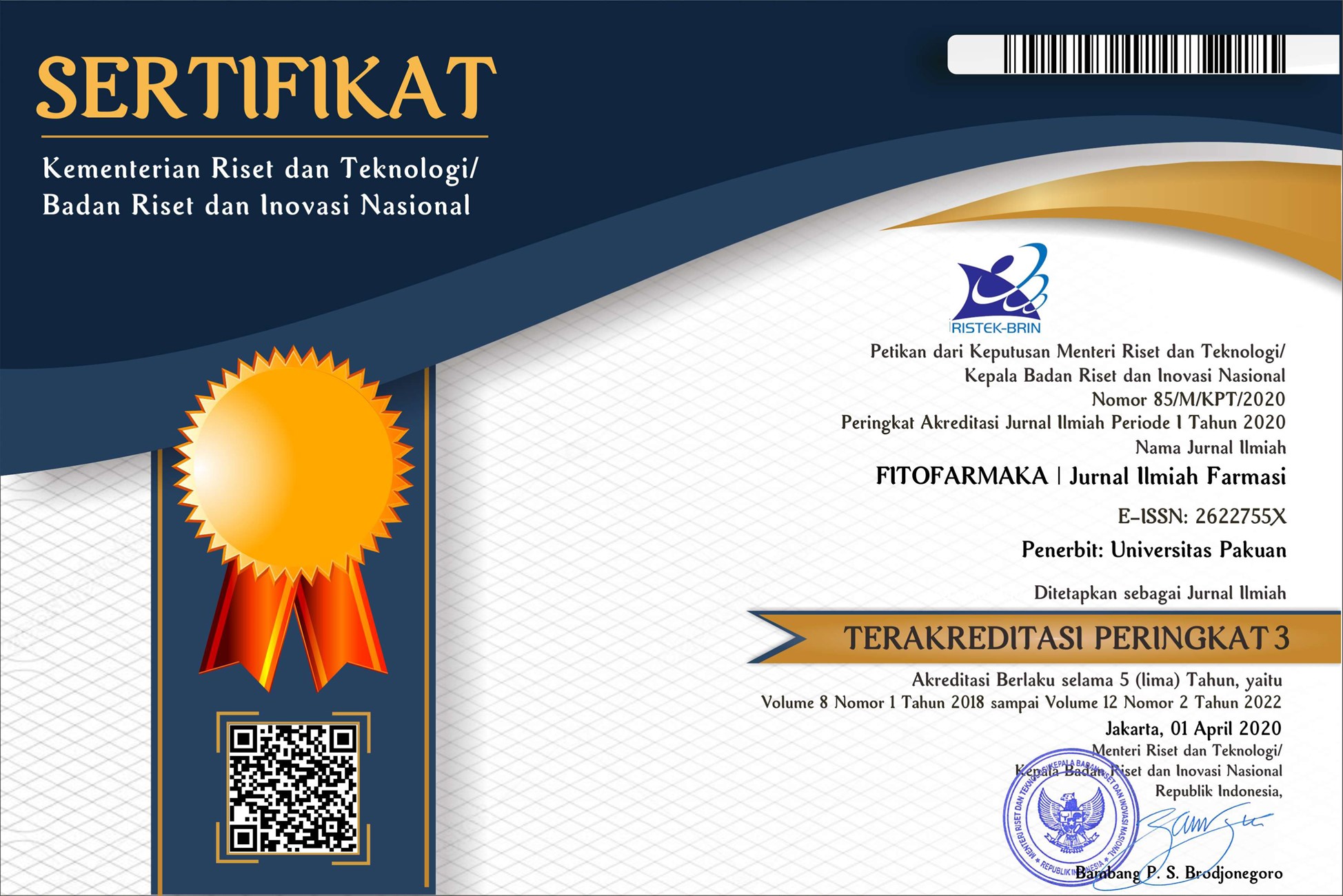REVIEW: KAJIAN SINTESIS MOLECULAR IMPRINTED POLYMER (MIP) UNTUK PENENTUAN ANABOLIK ANDROGENIK STEROID
Abstract
Molecular Imprinted Polymer (MIP) merupakan teknik pembuatan polimer berongga yang berfungsi sebagai sorben dengan selektivitas dan afinitas yang tinggi. Keberhasilan teknik MIP dalam pengaplikasiannya dilihat dari seberapa tingginya nilai imprinting factor (IF) dan kapasitas adsorpsi (KA) dalam mengadsorpsi suatu analit target. Tingginya kedua parameter tersebut dapat dipengaruhi oleh penggunaan monomer dan crosslinkers pada saat sintesis polimerisasi MIP. Tujuan dilakukan studi ini untuk memberikan informasi berupa nilai parameter IF dan KA dari penerapan MIP pada senyawa obat anabolik androgenik steroid (AAS). Review Jurnal ini dilakukan dengan menelusuri dan mengkaji jurnal ilmiah nasional maupun internasional tentang MIP dan AAS yang diperoleh dari situs google.com, google scholar, NCBI, dan Science Direct. Berdasarkan hasil review untuk memperoleh nilai IF dan KA yang tinggi bagi analit testosteron jika monomer yang digunakan adalah trifluoromethacrylic acid (TFMAA) yang dikombinasikan dengan crosslinker divinylbenzene (DVB) dan androsterone dimethacrylate (AnDMA), untuk analit estrogen seperti β-estradiol memperoleh nilai IF dan KA yang tinggi jika monomer yang digunakan adalah methacrylic acid (MAA) yang dikombinasikan dengan crosslinker ethylene glycol dimethacrylate (EGDMA).
Keywords
References
Augustine, Anju & Beena Mathew. (2014). Synthesis of Carbon Nanotube Incorporated Molecular Imprinted Polymer with Binding Affinity towards Testosterone.International Scholarly Research Network Polymer Science. 4:1-7 https://doi.org/10.1155/2014/790583.
Belbruno, Joseph J. (2018). Molecularly Imprinted Polymers. Chemical Reviews. 119:94119. https://doi.org/10.1021/acs.chemrev.8b00171.
Birzniece, Vita. 2014. Doping in sport: Effect, harm and misconceptions. Internal Medicine Journal. 45(3) . https://doi.org/10.1111/imj.12629.
Chen, Wei., Min Xue., Fei Xue., Xiangrong Mu., Zhibin Xu., Zihui Meng., Guangxian Zhu & Kenneth J Shea. (2015). Molecularly imprinted hollow spheres for the solid phase extraction of estrogens. Talanta. 140:68-72. https://doi.org/10.1016/j.talanta.2015.02.048.
Dirion B, E. Schillinger, B. Sellergen. (2004). Development of a high throughput synthesis technique for the optimization of MIPs for 17β-Estradiol. Materials Research Society Symposium Proc. 787;G4.3.1-G4.3.8p
Du, Wei., Chunmei Lei., Siruo Zhang., Gang Bai., Huiyan Zhou., Min Sun., Qiang Fu & Chun Chang. (2014). Determination of Clenbuterol from Pork Samples Using Surface Molecularly Imprinted Polymers as the Selective Sorbents for Microextraction in Packed Syringe. Journal of Pharmaceutical and Biomedical Analysis. 91:16068. https://doi.org/10.1016/j.jpba.2013.12.022.
Fourou, Hana., Mohamed Braiek., Anne Bonhomme., Florence Lagarde., & Nicole Jaffrezic-renault. (2017). Voltammetric Sensor Based on a Double-Layered Molecularly Imprinted Polymer for Testosterone. Analytical Letters. 1-21. https://doi.org/10.1080/00032719.2017.1298118.
Gavrilovi´c, Ivana., Karen Mitchell., Alan D Brailsford., David A Cowan., Andrew T Kicman & Richard J Ansell. (2011). A Molecularly Imprinted Receptor for Separation of Testosterone and Epitestosterone , Based on a Steroidal Cross-Linker. Steroids. 76(5): 47883. https://doi.org/10.1016/j.steroids.2011.01.004.
Hand, Rachel A., Elena Piletska., Thomas Bassindale., Geraint Morgand & Nicholas Turner Man. (2020). Application of Molecularly Imprinted Polymers in the Anti-Doping Field: Sample Purification and Compound Analysis. Analyst. 14:1-24 https://doi.org/10.1039/D0AN00682C.
Hasanah, Aliya Nur., Rahmana Emran Kartasasmita & Slamet Ibrahim. (2015). Sintesis Sorbent Ekstraksi Fase Padat Dengan Teknik Molecular Imprinting Dengan Monomer Akrilamid Untuk Ekstraksi Glibenklamid Dari Serum Darah. Jurnal Farmasi Indonesia. 7(4): 233241. https://doi.org/10.35617/jfi.v7i4.255.
Kadhem AJ, Shuting X, Susan N, Chung-Ho L, Maria FC. (2018). Photonic Molecularly Imprinted Polymer Film for the Detection of Testosterone in Aqueous Samples. Polymers Multidisciplinary Digital Publishing Institute.10(349); 1-13p. DOI: 10.3390/polym10040349.
Kellens, Evelien., Hannelore Bove., Matthias Conradi., Lien D Olieslaeger., Patrick Wagner., Katharina Landfester., Thomas Junkers & Anitha Ethirajan. (2016). Improved Molecular Imprinting Based on Colloidal Particles Made from Miniemulsion: A Case Study on Testosterone and Its Structural Analogues. Macromolecules. 49(7): A-I https://doi.org/10.1021/acs.macromol.6b00130.
Miloš P. Pešić, Miljana D. Todorov, Gergely Becskereki, George Horvai, Tatjana Ž. Verbić dan Blanka Tothb. (2020). A Novel Method Of Molecular Imprinting Applied To The Template Cholesterol. Talanta. 217. https://doi.org/10.1016/j.talanta.2020.121075
Marfuah, Nurul., I Wayan Kasa & Sagung Chandra Yowani. (2014). Pengaruh Steroid Anabolik Methandienone Terhadap Kuantitas Spermatozoa Tikus Putih ( Rattus Norvegicus ). Jurnal Biologi.XVII(1): 2427. ISSN : 1410-5292.
Mazzeo, Filomena. 2016. Drug Abuse in Elite Athletes : Doping in Sports Sport. Sport Science 9 (2): 3441.
Mirmahdieh, Shiva., Azam Mardihallaj., Zahra Hashemian., Jalal Razavizadeh., Hassan Ghaziaskar & Taghi Khayamian. (2011). Analysis of Testosterone in Human Urine Using Molecularly Imprinted Solid-Phase Extraction and Corona Discharge Ion Mobility Spectrometry. Journal of Separation Scence 34: 10712. https://doi.org/10.1002/jssc.201000583.
Nawaz, Tehseen., Muhammad Ahmad., Jieying Yu., Shiqi Wang & Tianxin Wei. (2020). Biomimetic Detection of Progesterone by Novel Bifunctional Group Monomer Based Molecularly Imprinted Polymer Prepared in UV Light . New Journal of Chemistry. 44(17): 111. https://doi.org/10.1039/C9NJ06387K.
Qiu, Lijun., Wei Liu., Min Huang & Lan Zhang. (2010). Preparation and Application of Solid-Phase Microextraction Fiber Based on Molecularly Imprinted Polymer for Determination of Anabolic Steroids in Complicated Samples. Journal of Chromatography A. 1217 (48): 74617470. https://doi.org/10.1016/j.chroma.2010.08.056.
Rohayati, Astri., Aliya N. Hasanah., Nyi M. Saptarini & Anisa D. Aryanti. (2015). Optimization of Separation Condition of Glibenclamide and Metformin in Optimasi Kondisi Pemisahan Glibenklamid Kombinasi Metformin Dalam Plasma Darah Menggunakan KCKT. Indonesian Journal of Pharmaceutical Science and Technology. 2(3): 96104. https://doi.org/10.15416/ijpst.v2i3.7906.
Sari, Pamela K., Poppy M Lintong & Lily L Loho. (2015). Efek Pemberian Anabolik Androgenik Steroid Injeksi Dosis Rendah dan Tinggi Terhadap Gambaran Histopatologi Hati dan Otot Rangka Tikus Wistar (Rattus Novergicus). Jurnal E-Biomedik 3 (1): 5019. https://doi.org/10.35790/ebm.3.1.2015.7503.
Saylan, Ye¸seren., Semra Akgnüllü., Handan Yavuz., Serhat Ãœnal & Adil Denizli. (2019). .Molecularly Imprinted Polymer Based Sensors for Medical Applications. Multidisciplinary Digital Publishing Institute.19 (1279): 119. https://doi.org/10.3390/s19061279.
Suherman, Meilia., Ike Susanti., Driyanti Rahayu., Rimadani Pratiwi & Aliya N Hasanah. (2019). Performance Evaluation of Molecularly Imprinted Polymer Using Propanol as Porogen for Atenolol Recognition in Human Serum. Indonesian Journal of Pharmaceutical Science and Technology. 6 (1): 27-35. https://doi.org/10.24198/ijpstv6i1.18671.
Tristi Jessica dan Muchtaridi. (2018). Review : Molecularly Imprinted Polymer (MIP) untuk Isolasi Atenolol dalam Sampel Biologis. Farmaka. 16 (1); 304-315.
Utari, Ningtias Traju Dwi & Eli Halimah. (2011). Review: Penggunaan Monomer Asam Itakonat Pada Molecularly Imprinted Polymer (MIP). Farmaka. 16 (1): 21421. https://doi.org/10.24198/jF.V16I1.17447.
Wang, Yun., Enlan Wang., Ziming Wu., Huan Li., Zhi Zhu & Xinsheng Zhu. (2014). Synthesis of Chitosan Molecularly Imprinted Polymers for Solid-Phase Extraction of Methandrostenolone. Carbohydrate Polymers. 101: 51723. https://doi.org/10.1016/j.carbpol.2013.09.078.
World Anti-Doping Agency. 2019. World Anti-Doping Agency Code 2015 with 2019 Amandements. http://www.wada- ama.org/. Diakses pada tanggal 19 juli 2020.
World Anti-Doping Agency. 2020. The World Anti-Doping Code International Standard Prohibited List. http://www.wada- ama.org/. Diakses pada tanggal 19 juli 2020.
Xiao, Deli., Yue Jiang., & Yanping Bi. (2018). Molecularly Imprinted Polymers for the Detection of Illegal Drugs and Additives : A Review. Microchimica Acta 185(247): 120. https://doi.org/10.1007/s00604-018-2735-4.
Yang, Minli., Wancheng Gu., Li Sun., Feng Zhang., Yun Ling., Xiaogang Chu & Daning Wang. (2010). Study on the Molecularly Imprinted Polymers with Methyl-Testosterone as the Template. Talanta 81 : 15661. https://doi.org/10.1016/j.talanta.2009.11.051.
Zhu, Guifen., Xia Gao., Xiaolong Wang., Jianji Wang & Jing Fan. (2017). Influence of hidrogen bond accepting ability of anions on the adsorption performance of ionic liquid surface molecularly imprinted polymers. Journal of Chromatography A. 1532: 40-49. https://doi.org/10.1016/j.chroma.2017.11.057.
Zink, S., F. A. Moura., P. Alves da Silva Autreto., D. S. GalvaËœob & B. Mizaikof. (2018). Efficient Prediction of Suitable Functional Monomers for Molecular Imprinting via Local Density of States Calculations. Royal Society of Chemistry. 1315358. https://doi.org/10.1039/c7cp08283e.
DOI: 10.33751/jf.v11i1.2594
 Abstract views : 950
Abstract views : 950
Refbacks
- There are currently no refbacks.















